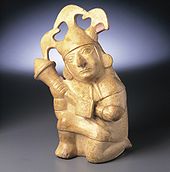Headgear
This article has multiple issues. Please help improve it or discuss these issues on the talk page. (Learn how and when to remove these template messages)
|


Headgear, headwear, or headdress is any element of
Purposes
Protection or defence
Headgear may be worn for
are worn for protection in battle or against impact, for instance when riding bicycles or motor vehicles. There are also hats that are worn for protection from the cold.Fashion
Headgear can be an article of
Religious significance
Some headgear is worn for religious reasons.
In
Traditionally, Christian women are required to wear a headcovering as taught in 1 Corinthians 11:2–16 (the same text teaches that men are to pray and worship with their head uncovered), which has been practiced since the time of the
Male
In
The black satin headgear called or known as "fenta" or "topi" is a pillbox-shaped skullcap, worn by Zoroastrians. It is considered by some in the Zoroastrian religion to be of vital spiritual importance. In earlier times, a saucer-shaped, red-and-white-striped kipah was the hallmark of the Zoroastrian.

Symbol of status or office
Headgear such as crowns and tiaras are worn in recognition of noble status especially among royalty. Wigs are worn traditionally by judges and barristers of Commonwealth nations.[
Other uses
Other purposes of headgear include:
- keeping hair contained or tidy (including scrunchies, ball caps, etc.)
- medical purposes, such as orthodontic headgear
- social convention
- sport uniform
- traditional ceremonies
Types
Bonnets

Bonnets, as worn by women and girls, were hats worn outdoors which were secured by tying under the chin, and often which had some kind of peak or visor. Some styles of bonnets had peaks so large that they effectively prevented women from looking right or left without turning their heads. Bonnets worn by men and boys are generally distinguished from hats by being soft and having no brim—this usage is now rare (they would normally be called caps today, except in Scotland where the "bunnet" is common in both civilian life and in the Royal Regiment of Scotland).
Caps
Crowns
Some headgear, such as the
Fillets
A
Hair covers
Hairnets are used to prevent loose hair from contaminating food or work areas. A snood is a net or fabric bag pinned or tied on at the back of a woman's head for holding the hair. Scarves are used to protect styled hair or keep it tidy. Shower caps and swim caps prevent hair from becoming wet or entangled during activity.
Hats
Hats often have a brim all the way around the rim, and may be either placed on the head, or secured with hat-pins (which are pushed through the hat and the hair). Depending on the type of hat, they may be properly worn by men, by women or by both sexes.
Helmets
Helmets are designed to protect the head, and sometimes the neck, from injury. They are usually rigid, and offer protection from blows. Helmets are commonly worn in battle, on construction sites and in many contact sports (most commonly being associated with American football). In most of the United States they are required by law for anyone operating a range of vehicles including motorcycles, and sometimes extending to bicycles and skateboards.
Hoods

Modern hoods are generally soft headcoverings which are an integral part of a larger garment, like an overcoat, shirt or cloak.
Historically, hoods were either similar to modern hoods, or a separate form of headgear. In medieval Europe hoods with short capes, called chaperons in French, were extremely common, and later evolved into elaborate and adaptable hats. Women's hoods varied from close-fitting, soft headgear to stiffened, structured hoods (e.g. gable hoods, hennins or French hoods) or very large coverings made of material over a frame which fashionable women wore over towering wigs or hairstyles to protect them from the elements (e.g. calash).
Masks
A
Orthodontic headgear

Orthodontic headgear is used to control the growth of the
Elastic bands are used to apply pressure to the bow or hooks which is then transferred to the patients teeth and jaw. Its purpose is to slow or stop the upper jaw from growing, thereby preventing or correcting an overjet. Other forms of headgear treat reverse overjets, in which the top jaw is not forward enough.[medical citation needed]
Turbans

Turbans are headgear, mostly for males, made up from a single piece of cloth which is wrapped around the head in a wide variety of styles. Turban is the best known word in English for a large category of headgear and general head wraps traditionally worn in many parts of the world. All over the world Sikhs wear a turban as religious headgear.
Turbans for women are a popular choice during chemotherapy treatment as an alternative to wigs, hats, headscarves and headbands. Sikh women also wear turbans as a religious practice. Turbans for women made in natural fabrics are both comfortable and functional. The Breast Cancer Care booklet, Breast Cancer and Hair Loss, suggests: "You may want to wear a soft hat or turban in bed to collect loose hairs."[10][11]
Veils and head wraps
A
Wigs
Culture-specific types
-
Bororo Indian men, Mato Grosso, Brazil
-
Tsimshian (Native American) Wooden Skull Headdress, late 19th century
Dhari
The dhari, also spelt dhoeri, is a distinctive headdress worn by men of the
The dhari is today a potent symbol for
War bonnet
Etiquette
This section needs additional citations for verification. (December 2022) |
In the

In the
In

In the
A hat can be raised (briefly removed and replaced, with either hand), or "tipped" (touched or tilted forward) as a greeting.
See also
- List of headgear
- List of hat styles
- Chapeaugraphy—an act in which a ring of felt is shaped to resemble many hat types
- Mathabana
References
- ISBN 978-0-924722-06-6.
Hippolytus, a leader in the church in Rome around the year 200, compiled a record of the various customs and practices in that church from the generations that preceded him. His Apostolic Tradition contains this statement: "And let all the women have their heads covered with an opaque cloth, not with a veil of thin linen, for this is not a true covering." This written evidence of the course of performance of the early Christians is corroborated by the archaeological record. The pictures we have from the second and third centuries from the catacombs and other places depict Christian women praying with a cloth veil on their heads. So the historical record is crystal clear. It reveals that the early generation of believers understood the head covering to be a cloth veil—not long hair.
- ^ "Veil". Early Christian Dictionary. Retrieved 7 September 2021.
- ^ Earle, Alice Morse (1903). Two Centuries of Costume in America, Vol. 2 (1620–1820). The Macmillan Company. p. 582.
One singular thing may be noted in this history, – that with all the vagaries of fashion, woman has never violated the Biblical law that bade her cover her head. She has never gone to church services bareheaded.
- ^ ISBN 9781317883876.
Today many people associate rules about veiling and headscarves with the Muslim world, but in the eighteenth century they were common among Christians as well, in line with 1 Corinthians 11:4-13 which appears not only to prescribe headcoverings for any women who prays or goes to church, but explicitly to associate it with female subordination, which Islamic veiling traditions do not typically do. Many Christian women wore a head-covering all the time, and certainly when they went outside; those who did not would have been barred from church and likely harassed on the street. … Veils were, of course, required for Catholic nuns, and a veil that actually obscured the face was also a mark of elite status throughout most of Europe. Spanish noblewomen wore them well into the eighteenth century, and so did Venetian women, both elites and non-elites. Across Europe almost any woman who could afford them also wore them to travel.
- ^ "On Head Coverings". Classical Christianity. 11 January 2012. Retrieved 25 January 2022.
And let all the women have their heads covered with an opaque cloth, not with a veil of thin linen, for this is not a true covering. (Apostolic Tradition Part II.18)
- ^ Hurton, William (1851). A Voyage from Leith to Lapland: Or, Pictures of Scandinavia in 1850. R. Bentley. p. 59.
The clerk removed his mantle at the conclusion of this part of the service, and he then retired to robe himself in a black gown and high white ruff (the every-day costume of the Lutheran clergy), in which he subsequently delivered his sermon. He also read and chanted in this black gown during a portion of the service.
- ^ Haddad, Sh. G. F. "The turban tradition in Islam". Living Islam. Retrieved 5 August 2013.
- ^ "Native American Headdresses: Facts for Kids". Retrieved 27 August 2013.
- ^ Children and Orthodontics: Types of Braces, Retainers, Headgear. www.webmd.com/oral-health/guide/children-and-orthodontics WebMD describes common types of orthodontics for children, including braces headgear, and retainers.
- ^ "Breast cancer and hair loss (BCC54) : Breast Cancer Care - Support and information for anyone affected by breast cancer". Archived from the original on November 25, 2009. Retrieved 2011-05-06.
{{cite web}}: CS1 maint: bot: original URL status unknown (link) - S2CID 258804155.
- ^ Georga, Yianna. "Syntetic & Natural Wigs". website. YiannaGR. Retrieved 17 September 2013.
- ^ a b "Headdress, Dari or Dhoeri, Meriam, Palm Island, East, Queensland, Australia, 1930s". Museums Victoria. Retrieved 7 December 2021.
- NITV. Retrieved 7 December 2021.
- ^ a b "Dhari". Queensland Museum. Retrieved 7 December 2021.
- Torres Strait Island Regional Council. Retrieved 7 December 2021.
- ^ "Alick Tipoti". Australian War Memorial. Retrieved 7 December 2021.
- ^ "Torres Strait land and sea dhari headdress". Cairns Art Gallery. Retrieved 7 December 2021.
- ^ "'Green Dancing Dhoeri (Dhari)' by John Barsa". Powerhouse Collection. Retrieved 7 December 2021.
- ^ "Behind First Nations headdresses: What you should know". CBC News. 27 March 2016. Retrieved 7 December 2021.
- ^ Ebrahim, Mufti (2003-06-21). "Q & A: Wearing Cap While Praying". Albalagh.net. Retrieved 2013-12-27.
External links
- The Head Covering Movement Christian head covering in the US
- Headgear Fashion Plates from The Metropolitan Museum of Art Libraries


